The kitchen unquestionably forms the core of every home. It serves as a domain of culinary inspiration, a sanctuary of warm family interaction. Among the essential aspects of a well-organized kitchen are its cabinets. Choosing the appropriate kitchen cabinet transcends mere visual appeal. It’s vital to comprehend the dimensions of kitchen cabinets, a key step towards curating a kitchen that blends practicality with aesthetic charm.
Kitchen Cabinet Basics: Dimension Details
Dimensions of kitchen cabinets encompass more than just length, width, and height. They also include the depth and the spatial footprint, crucial factors contributing to the kitchen’s overall functionality. Generally, standard kitchen cabinet dimensions can be segregated into three categories: base cabinets, wall cabinets, and tall cabinets.
Dimentions of Base Cabinets
As the backbone of kitchen storage, base cabinets ordinarily stand at a height of 34.5 inches and a depth of 24 inches. Once the countertop is mounted, its height usually extends to about 36 inches.
Dimentions of Wall Cabinets
Hung on the wall and commonly used for storing smaller utensils or dishes, these cabinets commonly have a depth of 12 inches. Their height and width can differ based on your kitchen design and layout.
Dimentions of Tall Cabinets
Perfect for storing cleaning supplies or functioning as a pantry, tall cabinets extend from the floor to the ceiling, generally around 84 to 96 inches tall and 12 to 24 inches deep.
Standard Kitchen Cabinet Dimensions: A Recap
Standard dimensions of kitchen cabinets serve as an excellent reference when planning your kitchen.
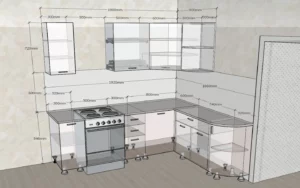
Standard Kitchen Cabinet Depth
Standard kitchen cabinet depth plays a crucial role in your kitchen’s overall functionality and layout. The typical depth for kitchen cabinets is 24 inches (61 cm). This depth allows for practical storage and countertop overhangs. However, there are variations and considerations to keep in mind:
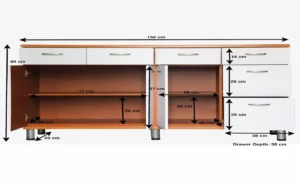
- Base Cabinets:Base cabinets, which typically store pots, pans, and other kitchen essentials, are usually 24 inches deep. This depth provides ample storage space while ensuring the countertop is at a comfortable working height.
- Wall Cabinets:Wall cabinets, used for storing dishes and glassware, are shallower than base cabinets, typically around 12 to 15 inches deep. This depth makes it easier to access items stored on higher shelves.
- Tall Cabinets:Pantry or utility cabinets can vary in depth, with some going up to 27 inches deep or more to accommodate larger items like brooms or small appliances.
- Customization:While standard depths are common, custom cabinetry allows you to tailor cabinet depths to your specific needs or kitchen layout. For instance, shallower cabinets may be more appropriate if you have limited space.
When planning your kitchen, consider your storage requirements, appliance sizes, and available space to determine the most suitable cabinet depths.
Optimal Kitchen Cabinet Sizes for Different Needs
Kitchen cabinet dimensions should be harmonious with your unique needs and available space. Think about the size of your appliances, required storage, and the total space of your kitchen.
For instance, if you’re an avid cook with a collection of kitchen gadgets, selecting deeper base cabinets could provide the required storage. Conversely, if you’re working with a smaller kitchen, efficiently using tall cabinets can enhance storage capacity without cramming the area.
Customizing Your Kitchen Cabinet Dimensions
While standard dimensions offer a preliminary guide to choosing kitchen cabinets, they’re not a rigid rule. Custom dimensions for kitchen cabinets are gaining traction. With custom cabinets, you can adjust the depth, width, and height to suit your kitchen’s requirements and tastes precisely.
The Impact of Kitchen Cabinet Dimensions on Design
Your kitchen cabinets’ dimensions can significantly influence your kitchen’s overall aesthetic. They can make your kitchen feel open and spacious or warm and cozy. Smaller cabinets yield more countertop space and foster an airy atmosphere, while larger ones offer more storage and can instill a sense of magnificence.
Read more about kitchen cabinet design
The Importance of Proper Measurement for Kitchen Cabinet Dimensions
The importance of accurate measurements when choosing kitchen cabinets must be considered. Mistakes in measurements result in ill-fitting cabinets or failing to meet your storage needs. When measuring, consider the total height and length of the walls, the dimensions of windows and appliances, the placement of plumbing, electrical outlets, and the total space available.
Balancing Aesthetics and Function in Kitchen Cabinet Dimensions
While the practical aspect of your kitchen cabinet dimensions is crucial, the aesthetic appeal is equally significant. Ensuring that your cabinet dimensions harmonize with your kitchen’s style is important. For example, sleek, streamlined cabinets might be appropriate for a modern minimalist look. In contrast, cabinets with more depth and height might be more fitting for a classic, traditional aesthetic.
Maximizing Space with Kitchen Cabinet Dimensions
Skillfully using kitchen cabinet dimensions can greatly enhance the efficiency of your kitchen space. Consider taller, more slender cabinets for compact kitchens to utilize vertical space fully. Additionally, incorporating sliding drawers within your cabinets can present a convenient storage option without the necessity for extra width.
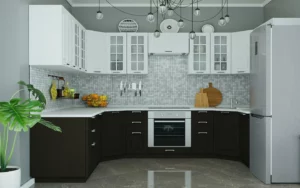
Exploring Kitchen Island Cabinet Dimensions
Introducing a kitchen island into your space can drastically change the game, offering supplementary workspace and storage. The dimensions of kitchen island cabinets usually resemble those of base cabinets, but they can be personalized according to your requirements. Remember the need for seating space and passageways when determining your island cabinet dimensions.
Factors to Consider for Corner Kitchen Cabinet Dimensions
Corner kitchen cabinets present a distinctive challenge. They can turn into storage black holes for kitchen utensils if not planned well. Consider solutions like Lazy Susans or corner drawers when charting your corner cabinet dimensions, which can transform these difficult corners into practical storage.
Explore more pvc kitchen cabinets
Significance of Ergonomics in Kitchen Cabinet Dimensions
The ergonomics of your kitchen significantly contribute to a comfortable cooking and dining atmosphere. Therefore, kitchen cabinet dimensions should be planned with ergonomics as a focal point. The height and reach of wall cabinets, the depth of base cabinets, and the convenience of drawers should all cater to the kitchen’s users for a smooth and efficient experience.
Taking into account these diverse elements of kitchen cabinet dimensions, you can formulate a kitchen design that is visually pleasing and highly functional. The key is to strike a balance between your needs, style, and the practicalities of kitchen space.
Influence of Appliances: Kitchen Cabinet Dimensions and Your Equipment
Kitchen appliances considerably impact the layout and dimensions of your cabinets. Large equipment like stoves, dishwashers, and refrigerators must be seamlessly integrated into the kitchen design. Therefore, please consider your appliance dimensions before finalizing your cabinet sizes to ensure adequate space for them without compromising an efficient kitchen workflow.
Unique Features in Kitchen Cabinets
Certain cabinets have unique features, such as inbuilt spice racks, pull-out trash bins, or plate organizers. These features can notably affect your cabinet dimensions. Such features necessitate additional space, so planning your cabinet dimensions with these in mind is essential. Remember, these unique elements significantly enhance your kitchen’s functionality and simplify cooking and cleaning.
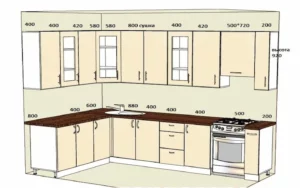
Adapting Kitchen Cabinet Dimensions to Compact Spaces
Small kitchens require intelligent use of space, so well-designed kitchen cabinet dimensions should assist. You should consider extending the height of your cabinets to use vertical space. Pull-out cabinets or sliding drawers can also serve as excellent solutions for compact spaces, providing easy access without requiring additional room for doors to open.
Explore more buying kitchen cabinets
The Influence of Kitchen Cabinet Dimensions on Budget
Lastly, understanding how kitchen cabinet dimensions can impact your budget is crucial. Larger cabinets, or those with special features, might cost more than their smaller, standard counterparts. Conversely, custom cabinets designed to match your specific needs are a worthwhile investment, preventing future space and functionality problems. It’s vital to reconcile your design aspirations with your budget limitations to create a kitchen that meets your needs without causing financial strain.
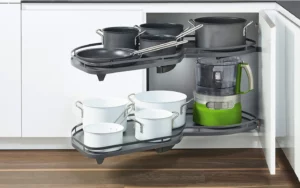
In conclusion, grasping kitchen cabinet dimensions is a key step in fabricating a kitchen that harmoniously merges functionality with aesthetics. While standard dimensions provide a valuable reference, customizing your kitchen cabinet dimensions to suit your needs is equally important. Remember, your kitchen reflects your lifestyle and taste; your cabinet choices should effectively convey this.
KEYWORDS:
